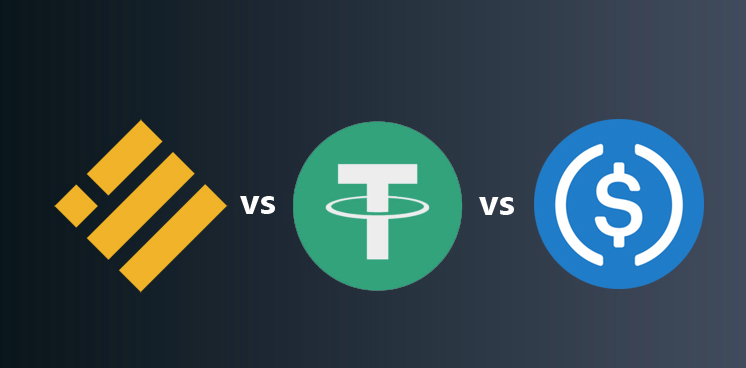In the rapidly evolving landscape of cryptocurrency, stablecoins have emerged as a cornerstone for providing stability amidst volatility. Unlike traditional cryptocurrencies, stablecoins are designed to maintain a stable value by pegging to a fiat currency or asset, often the U.S. dollar.

Among the many stablecoins available, USDT (Tether), USDC (USD Coin), and BUSD (Binance USD) are among the most prominent. This guide by Coin Leadge delves into the similarities and differences between these three stablecoins, providing insights into their functional attributes and unique characteristics.
What are Stablecoins?
Stablecoins have become a pivotal innovation in the cryptocurrency landscape, aiming to deliver the benefits of blockchain technology while minimizing the volatility associated with traditional cryptocurrencies like Bitcoin and Ethereum.
Fundamentally, a stablecoin is a type of cryptocurrency that is pegged to a stable asset, such as a fiat currency (like the U.S. dollar) or a commodity (like gold), to maintain a relatively stable price.
Why Stablecoins Matter
One of the primary motivations behind the creation of stablecoins is the need for a digital asset that retains value consistency, facilitating transactions and economic activities without the usual unpredictability seen in the cryptocurrency market. This stability attracts businesses and individuals looking to utilize digital currencies for payments, lending, and other financial services.
Stablecoins provide a refuge for traders and investors during market volatility by offering a safe harbor to park their funds without relying on traditional fiat currency exchanges. Moreover, they serve as an effective gateway for transitioning between fiat currencies and cryptocurrencies, often acting as a stable intermediary in volatile markets.
How Stablecoins Work
Stablecoins employ various mechanisms to maintain their price stability:
- Fiat-Collateralized Stablecoins: These are backed by reserves of fiat currency, which are held in a bank account. For instance, each issued stablecoin unit is equivalent to one unit of the fiat currency, commonly USD. USDT (Tether) and USDC (USD Coin) are examples of fiat-collateralized stablecoins.
- Crypto-Collateralized Stablecoins: These stablecoins use other cryptocurrencies as collateral, held in smart contracts on the blockchain. To account for cryptocurrency volatility, these stablecoins are often overcollateralized, meaning the value of the collateral exceeds the value of the issued stablecoins. An example is DAI, which uses Ethereum as collateral.
- Algorithmic Stablecoins: These do not rely on collateral but instead use algorithms and smart contract mechanisms to control the stablecoin’s supply. The algorithm automatically adjusts the supply based on market demand to maintain a set price level. An example is Ampleforth, which has an adaptive supply governed by an algorithm.
Stablecoins serve essential roles within the crypto ecosystem, acting as a bridge between fiat currencies and cryptocurrencies. They provide liquidity and facilitate trading on cryptocurrency exchanges, offering an alternative for traders who wish to mitigate risk exposure associated with fluctuating markets.
While all stablecoins aim to maintain a stable value, their frameworks and management differ significantly.
Overview of USDT, USDC, and BUSD
USDT (Tether): Launched in 2014, Tether is one of the earliest and most widely used stablecoins. It is issued by Tether Limited and aims to maintain a 1:1 value ratio with the U.S. dollar, backed by reserves of cash, cash equivalents, or other assets.
USDC (USD Coin): Introduced by the Centre Consortium, a collaboration between Circle and Coinbase, USDC emerged in 2018. It is a fully-backed digital dollar issued as a stablecoin, ensuring each unit is supported by fiat reserves.
BUSD (Binance USD): Introduced in collaboration between Binance, one of the world’s largest cryptocurrency exchanges, and Paxos, BUSD is a USD-backed stablecoin launched in 2019. Each BUSD coin is backed by 1:1 reserves of U.S. dollars held in FDIC-insured U.S. banks.
Issuers and Regulatory Compliance
USDT: Tether Limited, the issuer of USDT, has faced scrutiny and legal challenges regarding the transparency of its reserves. Despite these challenges, it remains a highly utilized stablecoin.
USDC: Backed by established companies in the crypto space, USDC prides itself on transparency. Circle conducts third-party audits to ensure that reserves are adequate, making it one of the more regulated stablecoins in terms of financial oversight.
BUSD: As a product of Binance in partnership with Paxos, BUSD meets regulatory standards enforced by the New York State Department of Financial Services (NYDFS). Paxos regularly undergoes audits to verify the dollar reserves backing the BUSD.
Various purposes in the crypto sector
Stablecoins like USDT, USDC, and BUSD are versatile, used for various purposes in the crypto sector:
- Trading and Exchanges: All three stablecoins are extensively used as trading pairs on numerous cryptocurrency exchanges, providing liquidity and enabling seamless trading operations.
- Decentralized Finance (DeFi): Stablecoins facilitate participation in various DeFi protocols, enabling lending, borrowing, and earning interest on platforms like Compound, Aave, and Uniswap.
- Cross-Border Transactions: They offer an efficient means for executing cross-border transactions, minimizing fees and reducing dependency on traditional banking systems.
Similarities Between USDT, USDC, and BUSD
Despite their differing specifics and origins, these stablecoins share core functionalities and characteristics:
- Price Stability: Each aims to maintain a stable price pegged to the U.S. dollar, providing a reliable medium for trading and transactions.
- Fiat Backing: All three stablecoins claim to be backed by equivalent fiat currency reserves, ensuring redeemability at a 1:1 ratio with the U.S. dollar.
- Blockchain Compatibility: They are deployed across multiple blockchains, including Ethereum, facilitating broad access and integration within the crypto ecosystem.
Differences Between USDT, USDC, and BUSD
USDT: While Tether claims to back its coins with equivalent fiat reserves, it has historically been less transparent, providing limited details on reserve audits.
USDC: Distinguished by its transparency, USDC undergoes monthly audits conducted by third-party firms, providing public reports on reserve statuses, boosting investor confidence.
BUSD: BUSD also adheres to strict regulatory scrutiny, with reserves regularly audited by Paxos to ensure compliance with government standards.
Security and Risks: USDT, USDC, and BUSD
All stablecoins carry inherent risks, but their issuance and security protocols differ:
- USDT faces scrutiny primarily around its reserve claims, posing potential risks if adequate backings are questioned.
- USDC and BUSD benefit from partnerships with reputable companies and regular audits, reducing perceived risk levels due to enhanced transparency and compliance.
Impact on the Market: USDT, USDC, and BUSD
As vital instruments in the crypto ecosystem, these stablecoins will likely continue to play a critical role in market operations. Emerging technologies and regulatory developments may further shape their trajectories, emphasizing the importance of transparency and robust financial practices. As the sector evolves, understanding differences and underlying principles of USDT, USDC, and BUSD will aid in navigating their applications across diverse financial landscapes.
FAQ
Is USDC Better Than USDT?
USDC is favored for its high level of transparency and regular audits, offering reassurance regarding its reserves. USDT, being more established, benefits from greater liquidity and wider acceptance within the crypto community. While USDC emphasizes regulatory compliance and reliability, USDT offers convenience and market reach. Ultimately, the better option depends on whether a user prioritizes transparency or wider usability in their transactions.
Is it better to buy USDT or BUSD?
They are however different in that they function on different blockchains and facilitate access to various crypto assets. Binance USD (BUSD) and Tether (USDT) are also different for this obvious reasons. BUSD is known to have higher transparency when compared with USDT.
Is USDT equal to USDC?
Is USDT equal to USDC? Yes. Current USDC to USDT conversion rate is 1. Inversely, this means that if you convert 1 USDT you will get 1 USDC. The conversion rate of USDC/USDT has increased by 0% in the last hour and shrunk by 0% in the last 24 hours.
Is USDC safer than BUSD?
USDC is more heavily regulated and regularly audited. BUSD supposedly holds mostly cash, I haven’t looked into any audits but Binance is too profitable to take wild risks on a stablecoin.
What is the Binance USD?
Binance USD (BUSD) is a fiat-collateralized stablecoin that offers the advantages of transacting with blockchain-based assets while mitigating price risk. BUSD are issued as ERC-20 tokens on the Ethereum blockchain and are collateralized 1:1 by USD held in Paxos-owned US bank accounts.
Conclusion
In conclusion, while USDT, USDC, and BUSD serve similar purposes, their differences in regulatory compliance, transparency, and corporate backing reflect distinct approaches to maintaining stable currency values in the digital age. This detailed comparison offers a foundation for understanding how each stablecoin fits within the broader cryptocurrency landscape.

I’m a freelance writer specializing in investing and financial topics. I write for many different websites and have done extensive work with crypto websites like Investopedia. My work is available on my website: coinlegit.com



